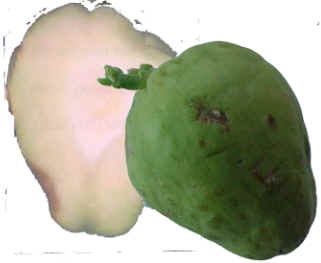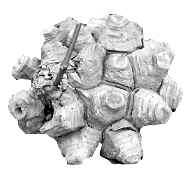

PITS NEWSLETTER
Volume 22 #2
Winter 2004
(Sechium edule)
Iíve trained my friends and neighbors well! Whenever they find
something sprouting in the vegetable bin they bring it to me. Such was the
case with a sprouting Chayote. Technically this is not a tuber, but a
perennial squash, but we grow it in the same manner as all the other tubers.
they bring it to me. Such was the
case with a sprouting Chayote. Technically this is not a tuber, but a
perennial squash, but we grow it in the same manner as all the other tubers.
The squash is lime-green, ovate and 4-6 inches long. The skin is smooth and slightly warty. Within the flesh, there is a large flat white seed about 2 inches long, sometimes called the vegetable scallop. It is edible and considered by some the tastiest part of the squash. As the fruit begins to shrivel, a vine emerges from the wider end as seen in the illustration.
Presently the above Chayote is resting at the base of the Banana tree and the vine is growing at the rate of several inches a day. As yet no roots, but as soon as these develop it must be moved to its own pot. The vine climbs by means of tendrils and needs a sturdy wire, trellis or form for support. When planted outdoors in a natural (tropical area) the vine can attain a height of 30 feet in one season.
The seed loses its vitality when removed from the fruit. When it comes time to plant, plant the whole fruit. The flesh will supply all the starch and water necessary for vigorous growth for months. It is doubtful that you will get fruit from a pot grown plant in the north. Chayote needs a long, hot growing season to set flowers and fruit. We have seen Chayote trained on an arbor in South Florida and it was a handsome sight, large ropy trunks twisted around the pillars and the squash hanging down from the top of the arbor.
Unlike other members of this family, the Chayote has tuberous instead of fibrous roots. These roots are also edible.
The light green leaves are typical palmate leaves of the squash family and can reach a width of 8 inches. They will be much smaller when grown in a pot.
To eat: You can prepare Chayote as you would a summer squash. It is a little mucilaginous but quite tasty. The following recipe is from the Brooklyn Botanic Garden:
Salad
3 Chayotes
2 Bell Peppers roasted, seeded, peeled and sliced. (Red and Yellow )
1 small Red Onion, thinly sliced
12 Olives
2 TBS Caper Berries
3 ripe Avocados, peeled and sliced
1/2 Cup chopped fresh Cilantro
1 bunch of Watercress, stems removed
Cut the Chayotes in half and simmer until soft, about 15 min. Cool and slice. Arrange Watercress, Peppers, Onion, Avocados, Chayotes, Olives and Caper Berries on individual plates. Sprinkle with chopped Cilantro and drizzle your favorite vinaigrette.
(Dioscorea elephantipes)
If you're into ĎDesigner Vinesí try this one from South Africa. The
"tuber" is a massive root stock (3 in when young to 20 in when
mature ) that is covered with a deeply fissured root bark. Natives actually
eat this plant in times of famine either boiled or raw. We donít advise
it. Elephantís Foot can only be purchased through rare plant and cactus
nurseries for a horrendous price. Ours when it was young and only 3 in
across cost $25.00 wholesale. It is a wonderful conversation piece!
this plant in times of famine either boiled or raw. We donít advise
it. Elephantís Foot can only be purchased through rare plant and cactus
nurseries for a horrendous price. Ours when it was young and only 3 in
across cost $25.00 wholesale. It is a wonderful conversation piece!
The vine is deciduous, usually dies back during the summer months when you donít want shades. The leaves turn yellow and drop. At this time the plant is dormant and all water should be with held. Once the vines begin to sprout in early November, resume light watering. Water as you would a cactus, "When it rains in Arizona".
The leaves are heart-shaped, 3-4 inches across, dark glossy, olive green and deeply veined. Ours is about 7 inches across and sends up a 20 foot vine annually. Elephantís Foot is a collectors item, but remarkably easy to grow. It will be with you for years with no effort.
Trowel & Error
Lovejoy, Sharon
Workman Pub. 2003
Pp 208, $ 13.95
This slim volume is subtitled 700 Tips and Remedies for the Gardener. I
didnít count the entries but there seems to be something for even the most
experienced gardener. Did you know the you can use NPK fertilizer or Urea on
icy walk ways? It melts the ice and the run off isnít as damaging as
melting salt ? Or that you can use unwanted cheap cologne on mealybugs,
whitefly and aphids (but you better hide it when the giver visits) ?
fertilizer or Urea on
icy walk ways? It melts the ice and the run off isnít as damaging as
melting salt ? Or that you can use unwanted cheap cologne on mealybugs,
whitefly and aphids (but you better hide it when the giver visits) ?
The author has a sense of humor. The book has ten chapters one of which in on indoor plants. Chapters on pests and bugs reveal the authors basically organic philosophy. The volume ends with an excellent appendix and list of sources and organizations the reader may wish to consult for seeds, plants or other information e.g.. sources of beneficial insects or bats.
I loved this little book. It is easy and fun to pick up and read. Reservations ? Lovejoy suggests using a station wagon parked in a cool place as a temporary green house. Weíve done this but the inside windows fogged up so completely that the car was undriveable. The use of a hanging enema bag to water hanging plants-- though undoubtedly effective--struck us as aesthetically counterproductive.
John Hart